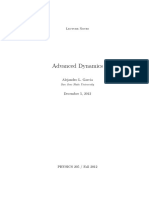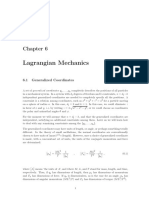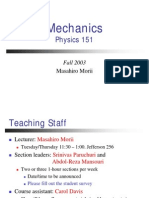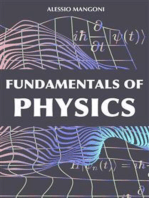Lecture01 Elementary Principles
Uploaded by
Jitendra SinghLecture01 Elementary Principles
Uploaded by
Jitendra SinghMechanics
Physics 151
Lecture 2
Elementary Principles
(Goldstein Chapter 1)
Administ ravia
! First Problem Set
! 3 problems for the section
! Work on them before coming to your section!
! 3 for the report (due next week)
! If you havent filled the Survey, please do it
! We need it for sectioning and study-grouping
! Section time: Tue. 6 PM, 7 PM and Wed. 5 PM
! If none of these slots works for you, let me know
! Sectioning will be announced on Monday by email
! We will also assign you into study groups (~6 each)
What We Did Last Time
! Reviewed basic principles of Newtonian Mechanics
! Define standard notations and usages
! Momenta, conservation laws, kinetic & potential energies
! Concentrated on the motion of a single particle
Goals for Today
! Single "multi-particle system
! Force between particles
! Laws of action and reaction
! Introduce constraints
! Holonomic and nonholonomic constraints
! Introduce Lagranges Equation
Newtons 3
rd
Law
Syst em of Part icles
! More than one particles? "Just add indices!
! Subtlety: F may be working between particles
! Distinguish between internal and external forces
! Now add up over i to see the overall picture
i i
L N
!
=
i i
p F
!
=
( ) e
i ji i
j
= +
F F F
Force acting
on particle i
Force from particle j
Force from outside
Sum of Part icles
! This term vanishes if
! Weak law of action and reaction
( )
( ) ( )
,
e e
i ji i ji ij i
i i j i i j i
i j
<
= + = + +
F F F F F F
ji ij
F F =
Forces two particle exert on each other are equal and opposite
Forces two particle exert on each other are equal, opposite,
and along the line joining the particles
! C.f. the strong law of action and reaction
( ) e
i i
i i
=
F F
Sum of Part icles
! Now consider the equations of motion
! Define center of mass
= = =
i
i i
i
i
i
e
i
i
i
m
dt
d
r p F F
2
2
) (
!
Center of mass moves like a particle of mass Munder total
external force F
(e)
i i i i
i
m m
m M
=
r r
R
) ( ) ( e
i
e
i
M F F R =
! !
Tot al Linear Moment um
! The sum of the linear momenta is
! Taking the time derivative
! Conservation of total linear momentum
R r p P
!
!
M m
i
i i
i
i
= = =
) (e
M F R P = =
! ! !
If the total external force F
(e)
is zero, the total linear momentum
P is conserved
Assumed weak law of action & reaction
Newtons equation
of motion for the
center of mass
Tot al Angular Moment um
! The sum of the angular momenta is
! Take time derivative and use
! This term vanishes only if F
ji
satisfies the strong law of
action and reaction
= =
i
i i
i
i
p r L L
) (e
i
j
ji i i
F F F p + = =
!
+ =
i
e
i i
j i
j i
ji i
) (
,
F r F r L
!
Total external
torque
Tot al Angular Moment um
! Assuming strong law of action and reaction
"Conservation of total angular momentum
) ( ) ( ) ( e
i
e
i
i
e
i i
N N F r L = = =
!
If the total external torque N
(e)
is zero, the total angular
momentum L is conserved
A multi-particle system (= extended object) can be treated
as if it were a single particle if the internal forces obey the
strong law of action and reaction
Laws of Act ion and React ion
! Most forces we know obey strong law of
action and reaction
! Gravity, electrostatic force
! There are rare exceptions
! E.g. Lorenz force felt by moving charges
! Conservation of linear & angular momenta fails
+Q
+Q
v
1
v
2
F
21
= 0
F
12
! Take into account the EM field
! Particles exchange forces with the field
! The field itself has linear & angular momenta
"Conservation laws restored
Conservat ion Laws
! We will see (in 2 lectures) that P and L must be
conserved if the laws of physics are isotropic in space
! No special origin
! No special orientation
! If we accept these symmetries as fundamental
principles, all forces must satisfy the action-reaction
laws "Proof of Newtons 3
rd
Law
Conservation of P
Conservation of L
Weak law of action-reaction
Strong law of action-reaction
Tot al Angular Moment um
! Define particle is position from the center of mass
! Also define the velocities
! Calculate the total angular momentum
R r r =
i i
R v
!
=
i i
r v
!
=
( ) ( )
+
= =
i
i i i
i
i i
m v v R r p r L
+ =
i
i i i
m M v r v R L
Angular momentum of
motion concentrated at
the center of mass
Angular momentum
of motion around the
center of mass
Kinet ic Energy
! The work done by force
! Positions 1 and 2 are now configurations (sets of positions)
! Use equations of motion to derive
! One can split T into two pieces
=
i
i i
d W
2
1
12
s F
1 2 12
T T W =
=
i
i i
v m T
2
2
1
where
+
+ =
i
i i
i
i i i
v m Mv m T
2 2
2
1
2
1
) ( ) (
2
1
v v v v
Motion concentrated at
the center of mass
Motion around the
center of mass
Pot ent ial Energy
! Assume conservative external force
! Assume also conservative internal forces
! To satisfy strong law of action/reaction
2 2
2
( )
1
1 1
e
i i i i i i
i i i
d V d V = =
F s s
|
|
.
|
\
|
i i i
i
z y x
i i
e
i
V =
) (
F
ij i ji
V = F
|) (|
j i ij ij
V V r r =
Potential depends only
on the distance
j i
j i
ij
V
,
2
1
2
1
2 2
1 1
, ,
ji i i ij i
i j i j
i j i j
d V d
=
F s s
Bit of work
Energy Conservat ion
! If all forces are conservative, one can define total
potential energy:
! Then the total energy T + V is conserved
! The second term is internal potential energy
! It depends on the distances between all pairs of particles
! Constant if particles relative configuration is fixed
"Rigid bodies
+ =
j i
j i
ij
i
i
V V V
,
2
1
Const raint s
! Equation of motion assumes
that particles can
move anywhere in space
! Not generally true
! In fact never true Free space is an idealization
! Amusement-park ride constrained (hopefully) on a rail
! Billiard balls on a pool table
! How can we accommodate constraints in the equation
of motion?
! Depends on the type of the constraint
+ = =
j
ji
e
i i i i
m F F F r
) (
! !
Holonomic Const raint s
! Constraints may be expressed by
! Particle on the x-y plane
! Rigid body
! All other cases are called nonholonomic
! It means we dont really want to mess with it
! May be inequalities such as
! May depend on derivatives such as
! We will deal only with holonomic constraints
0 ) , , , , (
3 2 1
= t f r r r
0 z
0 ) (
2 2
=
ij j i
c r r
A holonomic
constraint
i
r
!
0 = z
I ndependent Variables
! A holonomic constraint reduces the number of
independent variables by 1
! If z = 0, you are left with only x and y
! You may be able to solve the constraint for one variable
! Then you can drop this variable
! You may have to switch to a different set of variables
! For a particle on a sphere
a good choice is (, )
! New set of variables "Generalized coordinates
0 ) , , , , (
3 2 1
= t f r r r ) , , , , , (
3 2 1 1 1
t z y g x r r =
2 2 2 2
c z y x = + +
Generalized Coordinat es
! N particles have 3N degrees of freedom
! Introducing k holonomic constraints reduces it to 3N k
! Using generalized coordinates q
1
, q
2
,, q
3N k
! Example:
) , , , , (
3 2 1
t q q q
i i
r r =
Transformation equations from (r
l
) to (q
l
)
=
=
=
cos
sin sin
cos sin
c z
c y
c x
Transformation
from (x, y, z)
to (, )
Now What ?
! We know the equations of motion for (r
i
)
! We know how to include constraints by switching to
generalized coordinates
! How can we transform the equation of motion to the
generalized coordinates?
+ = =
j
ji
e
i i i i
m F F F r
) (
! !
) , , , , (
3 2 1
t q q q
i i
r r =
Lagranges Equations
Why Const raint s?
! Constraint is an idealized classical concept
! Nothing is perfectly constrained in QM
! How useful is it to switch between coordinates?
Uncertainty
More than it seems
Const raint s and Force
! A holonomic constraint is an infinitely strong force
! Or an infinitely high potential wall
! Reality is always smoother
! E.g. electron of a hydrogen atom
free
constrained
V(r)
V(r)
r
Its still true that the
electron feels strong
radial (binding) force,
while it can move
freely around the
nucleus
Binding force
makes the r
direction special
Force and Symmet ry
! Without forces, all coordinate systems are equal
! x-y-z system is the simplest
! Forces break the symmetry
! Some coordinate system works better than others
! Generalized coordinates offer natural way of handing
systems with such forces
! Constraints are extreme cases
! We develop our technique with them
OK, back to the business
Lagranges Equat ions
! Express L = T V in terms of generalized coordinates
, their time-derivatives , and time t
! The potential V = V(q, t) must exist
! i.e. all forces must be conservative
! Lets do a quick example to see how it works
0
j j
d L L
dt q q
| |
=
|
|
\ .
!
( , , ) L q q t T V
!
Kinetic energy
Potential energy
Lagrangian
Recipe
{ }
j
q { }
j
q
!
Ex: Part icle on a Line
! A particle moving on the x-axis
! Kinetic and potential energies:
! Equivalent to Newtons Eqn given that
0
j j
d L L
dt q q
| |
=
|
|
\ .
!
( ), 0, 0 x x t y z = = =
2
2
m
T x =
! ( ) V V x =
2
( )
2
m
L x V x =
!
Lagranges Eqn
0
V
mx
x
+ =
!!
x
V
F
x
OK, it works
Summary
! Discussed multi-particle systems
! Internal and external forces
! Laws of action and reaction
! Momenta, conservation laws, kinetic & potential energies
! Introduced constraints
! Holonomic and nonholonomic constraints
! Generalized coordinates
! Introduced Lagranges Equations
! Next: Prove that Lagranges and Newtons Equations are
equivalent
You might also like
- Goldstein Classical Mechanics Notes (Michael Good 2004)100% (1)Goldstein Classical Mechanics Notes (Michael Good 2004)149 pages
- Goldstein Classical Mechanics Notes: 1 Chapter 1: Elementary PrinciplesNo ratings yetGoldstein Classical Mechanics Notes: 1 Chapter 1: Elementary Principles149 pages
- Goldstein Classical Mechanics Notes: 1 Chapter 1: Elementary PrinciplesNo ratings yetGoldstein Classical Mechanics Notes: 1 Chapter 1: Elementary Principles149 pages
- Advanced_Classical_Mechanics_summary of conceptsNo ratings yetAdvanced_Classical_Mechanics_summary of concepts24 pages
- Mth-382 Analytical Dynamics: MSC MathematicsNo ratings yetMth-382 Analytical Dynamics: MSC Mathematics51 pages
- 05 Constraints, degrees of freedom, motion under frictionNo ratings yet05 Constraints, degrees of freedom, motion under friction11 pages
- Lecture Notes On Theoretical Physics: Himanshu Sahu October 12, 2020No ratings yetLecture Notes On Theoretical Physics: Himanshu Sahu October 12, 202034 pages
- Classical Mechanics-Pdf by Dr. Rajesh MathpalNo ratings yetClassical Mechanics-Pdf by Dr. Rajesh Mathpal45 pages
- Survey of The Elementary Principles - Part - 1No ratings yetSurvey of The Elementary Principles - Part - 125 pages
- 2 - Constraints and Lagrangian DynamicsNo ratings yet2 - Constraints and Lagrangian Dynamics102 pages
- Chapter 3 - Mechanics of Particle Systems and Rigid BodiesNo ratings yetChapter 3 - Mechanics of Particle Systems and Rigid Bodies47 pages
- Unified Field Theory in a Nutshell1: The Quest for the Theory of EverythingFrom EverandUnified Field Theory in a Nutshell1: The Quest for the Theory of EverythingNo ratings yet
- Student Solutions Manual to Accompany Economic Dynamics in Discrete Time, secondeditionFrom EverandStudent Solutions Manual to Accompany Economic Dynamics in Discrete Time, secondedition4.5/5 (2)
- Goldstein Classical Mechanics Notes (Michael Good 2004)Goldstein Classical Mechanics Notes (Michael Good 2004)
- Physics: Laminated QuickStudy Reference GuideFrom EverandPhysics: Laminated QuickStudy Reference Guide
- Goldstein Classical Mechanics Notes: 1 Chapter 1: Elementary PrinciplesGoldstein Classical Mechanics Notes: 1 Chapter 1: Elementary Principles
- Goldstein Classical Mechanics Notes: 1 Chapter 1: Elementary PrinciplesGoldstein Classical Mechanics Notes: 1 Chapter 1: Elementary Principles
- 05 Constraints, degrees of freedom, motion under friction05 Constraints, degrees of freedom, motion under friction
- Lecture Notes On Theoretical Physics: Himanshu Sahu October 12, 2020Lecture Notes On Theoretical Physics: Himanshu Sahu October 12, 2020
- Chapter 3 - Mechanics of Particle Systems and Rigid BodiesChapter 3 - Mechanics of Particle Systems and Rigid Bodies
- Unified Field Theory in a Nutshell1: The Quest for the Theory of EverythingFrom EverandUnified Field Theory in a Nutshell1: The Quest for the Theory of Everything
- Student Solutions Manual to Accompany Economic Dynamics in Discrete Time, secondeditionFrom EverandStudent Solutions Manual to Accompany Economic Dynamics in Discrete Time, secondedition



























































